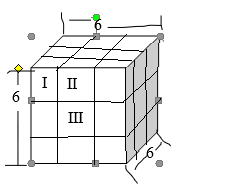
Concept explainers
a.
To calculate: The number of small cubes having six faces painted.
a.
Answer to Problem 11PSC
There are no small cubes having six faces painted.
Explanation of Solution
Given information:
A six inch cube is painted on the outside and cut into 27 smaller cubes.
Calculation:

The number of small cubes having various faces painted are as follows:
6 faces painted = 0,
5 faces painted = 0,
4 faces painted = 0,
3 faces painted = 8
2 faces painted = 10,
1 faces painted = 6,
No faces painted = 1.
8 cubes like ⏸.
12 cubes like ⏸.
6 cubes like ⏸.
1 in center.
b.
To find: The probability that it has at least two painted faces if one of the small cubes is selected at random.
b.
Answer to Problem 11PSC
The probability is
Explanation of Solution
Given information:
A six inch cube is painted on the outside and cut into 27 smaller cubes.
Formula used:
Probability of event to happen is
Calculation:

The number of small cubes having various faces painted are as follows:
6 faces painted = 0,
5 faces painted = 0,
4 faces painted = 0,
3 faces painted = 8
2 faces painted = 10,
1 faces painted = 6,
No faces painted= 1.
8 cubes like ⏸.
12 cubes like ⏸.
6 cubes like ⏸.
1 in center.
Probability means possibility.
The probability formula is defined as the possibility of an event to happen is equal to the ratio of the number of favorable outcomes and the total number of outcomes.
Probability of event to happen is
A six inch cube is painted on the outside and cut into 27 smaller cubes.
Thera are 27 total number of outcomes.
The number of favorable outcomes
P(two painted faces if one of the small cubes is selected at random)
c.
To calculate: The total area of the unpainted surfaces.
c.
Answer to Problem 11PSC
The total area of the unpainted surfaces is
Explanation of Solution
Given information:
A six inch cube is painted on the outside and cut into 27 smaller cubes.
Formula used:
Total area = Area of each cube
Calculation:

Each cube is 2 by 2, so the area of each cube = 4.
| Type of cube | Number of unpainted faces | Number of cubes | Number of unpainted faces |
| ⏸ | 3 | 8 | 24 |
| ⏸ | 4 | 12 | 48 |
| ⏸ | 5 | 6 | 30 |
| In center | 6 | 1 | 6 |
Total number of unpainted faces
Total area = Area of each cube
Total area
Chapter 12 Solutions
Geometry For Enjoyment And Challenge
Additional Math Textbook Solutions
Linear Algebra with Applications (2-Download)
Differential Equations and Linear Algebra (4th Edition)
Glencoe Math Accelerated, Student Edition
 Elementary Geometry For College Students, 7eGeometryISBN:9781337614085Author:Alexander, Daniel C.; Koeberlein, Geralyn M.Publisher:Cengage,
Elementary Geometry For College Students, 7eGeometryISBN:9781337614085Author:Alexander, Daniel C.; Koeberlein, Geralyn M.Publisher:Cengage, Elementary Geometry for College StudentsGeometryISBN:9781285195698Author:Daniel C. Alexander, Geralyn M. KoeberleinPublisher:Cengage Learning
Elementary Geometry for College StudentsGeometryISBN:9781285195698Author:Daniel C. Alexander, Geralyn M. KoeberleinPublisher:Cengage Learning

